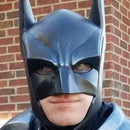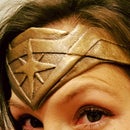Introduction: Glowing River Desktop
My wife and I have been planning on redoing our office so we can have a quiet place to do our work, and so our kids could do their homework where we are. We contemplated how we wanted our desk to look, knowing we wanted something awesome. We thought about granite (way too expensive) and other pre-made tops. For some reason, it just didn't feel right in my maker mind. Having seen some really cool river tables circulating the internet, I proposed the idea to my wife. She approved the idea whole heartedly.
To make it extra cool, I wanted the river to glow in the dark. The idea came to me after looking at Mikeasaurus' Glow Table. This would also help to give the river the blue that I wanted.
Step 1: Materials
Planning out how to make this table work at the lowest cost was a good challenge. We knew that we wanted the desktop to fill the entire length of our wall (11ft). It also had to be wide enough to cover the drawer bases we had purchase for the project. That in mind, these are the materials we used to make the desktop:
- 2 - 2 x 12 x 12 douglas fir planks
- wood biscuts
- wood glue
- Blue Glow Powder
- 3 gallons clear resin
- masking tape
- Java Gel stain
- Polyurethane finish
- Blue Glass (found at thrift store)
Tools:
- Table Saw
- Router
- Planer
- Sander
- Hammer
- Heat Gun
- Level
- Drill
Step 2: Join 2x12s
After cutting the two planks to the size of the wall (and test fitting them for good measure), I had to join them together in a way that would be solid. To do this, I ran one edge of each plank through the table saw about 3/4 of an inch deep. It is important that this Is done at the same level for each plank or they wont match up correctly.
Once the groove is in place, fill the gap with wood glue and place the biscuts about every 6 - 12". Then glue both edges to be stuck together. Then put the two pieces together and clamp them together. Wipe off any excess glue that comes out of the seam. It takes between 8 and 24 hours for the glue to be fully dried and cured.
Step 3: Draw Design & Router
After the glue was dried, I started to sketch out the design for the river. I looked at several rivers on line to get a sense of how they meandered. I also designed it so the island was in the middle of the desk. Once the design was penciled out by the approval committee (wife) I was ready to start routering the river bed.
This was a progressive process. I started by doing the whole area with a 1/4" deep cut. Then, I gradually deepened the layers a 1/4" at a time shaping out the form of the river. I did steeper banks where the water would run into it harder and wide banks where the water would be lazier.
Bit by bit, it developed a canyon like look to it. When the cutting was all done, my 4 year old shouted, "Dad, you made the Grand Canyon." Best compliment of the day.
Step 4: Sand
Before the staining and resin can be done, the table needs to be well sanded and leveled more. I started with a heavy grit sandpaper (60). I checked how level the top surface was and worked at getting it as level as possible. I progressively used finer sand paper until the surface smooth and free of scratches.
The underside also had some leveling problems. I got out a hand planer (wish I had an electric one) and sweated it out until it was more level. I then sanded it until smooth.
Step 5: Wood Prep, Stain & Poly
In order to get a good, even stain, it is important to use some wood conditioner. Once the whole surface was treated, we started the staining process. My wife and I spent a bit of time doing several trials with different stains to get a good color match with the drawer sets we purchased. Once that was figured out, we began applying the Java Gel. This stuff is the best and easiest stain I have found. You simply slop it on, smear it around, and then wipe it off. It was a much quicker process to do it this way.
Once it was all stained to our liking, we coated the whole surface with a polyurethane finish. This was recommended by the Resin company as it helps to minimize bubbling when the resin is poured on the wood.
Step 6: Tape Cracks and Dam It
Resin, as a liquid, will seep through any crack and find its way out. On the underside of the desktop we sealed the seam with making tape to prevent any leaking through and eventual dripping (nobody wants resin on their floor). We also did this with any knots that extended through the plank. Pretty much, anything that could leak through, will leak through. We masked it all.
Then, as the river extends out the two sides, those needed to be dammed up as well.I did several layers for this. Additionally, the sides and back needed to be dammed as I didn't want resin to coat those sides. I only wanted it to cover the front (visible) side.
Step 7: Level Desk
To prepare for pouring the resin, the table needs to be level. This needs to be done from front to back and side to side along the whole length of the table. I just propped stuff under the saw horses in order to accomplish this.
Step 8: Crush Glass
My wife decided that she wanted the river to have more texture in it. So off to the thrift store we went to find various blue colored glasses/vases. We then worked together to crush up the glass into the desired size. We did this inside a ziplock bag in order to prevent tiny shards of broken glass from getting everywhere.
Step 9: Glow Powder Resin (River)
The resin portion is quite possibly the hardest part of the process. The real challenge is to work out the bubbles before the resin hardens. So once you start, you have to stay really attentive for at least an hour.
Following the directions of the resin, I mixed in the glow powder with the resin and hardener. This has to be mixed just right, so follow the directions that come with it as closely as possible. You can also only pour about a 1/4" deep at a time, so it is a slow process. I ended up doing about 3 or 4 pours of the glow powder resin. Once you have poured a layer, you need to keep a hot heat source on it to work out the bubbles. The bubbles will keep coming for at least a half an hour. I used a heat gun for this on its hottest setting. You don't want to keep it in one place for too long or get too close as it can potentially ripple the resin. Keep doing this until you can't see any more of the little bubbles (you have to look close). This was harder to see with the blue, and less important.
You have to wait between 6 and 10 hours before pours so the heat of the resin doesn't get too hot. After the first two layers (and while it was still a little tacky, We placed the crushed glass into the river. After the resin set, we poured another layer in to get it all sealed into place. Again, stay on top of the heat.
Step 10: Clear Resin (Desktop)
Once the river portion is all done, it is time to do the clear, desktop portion. We ended up doing about 3 layers of this as well. It required way more resin than we anticipated because it was such a large surface.
Mix up as directed and slowly pour layers over the table. Pay close attention to areas like knots as the resin will seep into that and leave an unlevel surface. This is where the tape on the underside is so important. Some spots were still able to leak through and I had to add more tape.
Each layer should self level, and this came in handy with the divots created by the knots.
Keeping the heat going is so important on the clear part. If you don't get all the bubbles the surface ends up looking cloudy. This was rather hard with such a large surface. If I had to do it again, I would have two heat guns and/or a propane torch. We ended up having a few cloudy areas that we missed.
Step 11: Utility Holes
Since this is a desktop, it needed some spots for power cords to go through the table. I bought a couple caps and a 2" hole cutter. I cut the holes above where the outlets were for greater ease. Then I put the caps in the holes.
Step 12: Attach to Drawers
Once the table surface was all done, I was able to screw the draw bases into the desktop. This was a little challenging as the openings for the drawers made it hard to get a drill in, but it worked out nonetheless.
Step 13: Enjoy!
This was a quite a fun and challenging project. I love the way it turned out.
If you liked it, please consider voting for me in the Desk/Table contest as well as the Make It Glow contest.

Grand Prize in the
Tables and Desks Contest 2016

First Prize in the
Make it Glow Contest 2016












